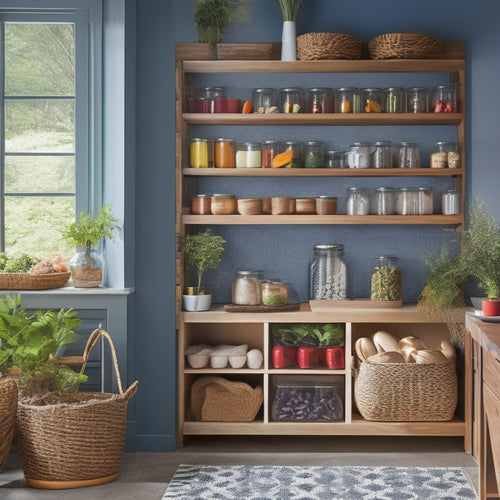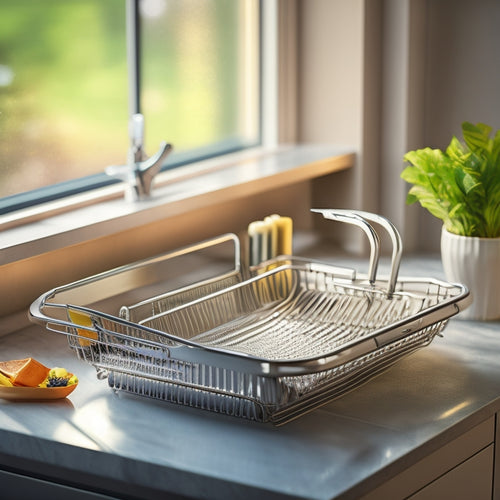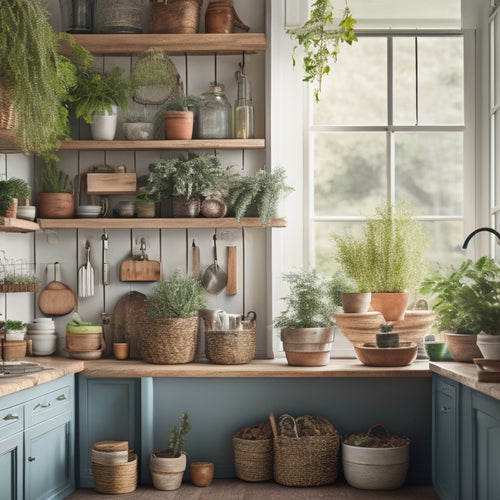
Simple Kitchen Utensil Organization for Seniors
Share
You're tired of wasting time and energy searching for kitchen utensils in cluttered drawers and countertops. To simplify your kitchen, start by keeping essential utensils within easy reach. Designate a specific area for storage and categorize utensils by type, prioritizing frequently used items. Consider tasks you perform most often and arrange utensils accordingly. Maximize your drawer space with dividers or organizers, and utilize vertical wall space with hooks or magnetic strips. By implementing these simple strategies, you'll be well on your way to a more organized kitchen that accommodates your needs. Now, explore how to create a utensil station that streamlines your cooking routine.
Key Takeaways
• Place frequently used utensils in an easy-to-reach location, such as a designated drawer or countertop area, for quick access.
• Use adaptive utensils with features like grip aids, contoured handles, or non-slip grips to accommodate arthritis or dexterity issues.
• Utilize vertical wall space by installing hooks, magnetic strips, or a pegboard to hang utensils and free up countertop and drawer space.
• Organize utensils by category, frequency of use, and size to simplify storage and retrieval in drawers or on countertops.
• Label utensils and containers to help identify items quickly and easily, reducing confusion and frustration in the kitchen.
Essential Utensils for Easy Access
You'll want to keep frequently used utensils, such as spoons, forks, and knives, within easy reach to avoid straining or struggling to access them. These must-have utensils should be placed in a convenient location, making meal prep and cooking a breeze. Consider designating a specific area, like a utensil holder or tray, near your cooking station to store these essentials.
When organizing your utensils, think about the tasks you perform most often in the kitchen. Do you frequently cook pasta or stir-fry vegetables? Make sure the utensils you need for these tasks are easily accessible.
You can also categorize your utensils by type, such as baking utensils, cooking utensils, and serving utensils, to help you quickly find what you need.
Maximizing Drawer Storage Space
How can you make the most of your kitchen drawers to store utensils, freeing up counter space and reducing clutter? By implementing a few simple strategies, you can create a more organized and accessible kitchen.
Start by using drawer dividers or space-saving organizers to separate utensils into categories, such as baking, cooking, or serving. This will help you find what you need quickly and easily.
Next, focus on efficient utensil arrangement. Place frequently used items in the front and center of the drawer, making them easy to grab. Consider arranging utensils by size, with larger items at the back and smaller ones at the front. This will create a logical and intuitive system.
To further enhance accessibility, consider adding tweaks such as pull-out drawers or adjustable dividers. These can help you reach items at the back of the drawer without having to dig through everything.
Utilizing Vertical Wall Space
Now that you've optimized your drawer storage, turn your attention to the often-underutilized real estate on your kitchen walls, where a few well-placed accessories can keep frequently used utensils within easy reach.
You can install hanging hooks or magnetic strips to hold utensils like spatulas, whisks, and ladles. This will free up space in your drawers and make it easier to find what you need.
Consider investing in a pegboard organization system, which allows you to customize the layout to fit your specific needs. You can hang pots, pans, utensils, and even kitchen gadgets from the pegs, keeping them organized and within reach.
Shelf baskets are another great option for storing smaller items like spices, oils, or condiments. They can be mounted on the wall or placed on a shelf, keeping your countertops clear.
Decluttering Countertop Clutter
With your walls and drawers organized, it's time to tackle the countertops, where clutter can quickly accumulate and make meal prep a frustrating experience. Start by clearing everything off your countertops and sorting items into categories, such as baking, cooking, and utensils.
Be honest with yourself - do you really need that bread maker or can you store it in a cabinet or donate it? Consider organizing cabinets with hidden storage solutions like turntables, baskets, or shelves to keep items you use less frequently out of sight. Labeling utensils and containers can also help you quickly identify what's inside, making it easier to find what you need when you need it.
Use visual cues like color-coding or grouping similar items together to create a sense of order. As you put items back on your countertops, group them by frequency of use and keep the most-used items front and center.
Adapting Utensils for Arthritis
As you've streamlined your kitchen space, you may still find that cooking and preparing meals is a struggle due to arthritis-related difficulties with gripping, twisting, or maneuvering utensils. This can be frustrating, but there are ways to adapt your utensils to make cooking easier and less painful.
Here are some adaptations you can make:
-
Add grip aids or custom handles to your utensils to make them easier to hold and maneuver
-
Switch to adaptive utensil designs with ergonomic grips that fit comfortably in your hand
-
Use utensils with larger, contoured handles that reduce strain on your joints
-
Choose utensils with angled or curved heads that require less twisting and turning
-
Consider using utensils with non-slip grips or textured handles to prevent dropping
Creating a Utensil Station
You're ready to take the next step in organizing your kitchen utensils by designating a specific station where you can easily access and store them. This station will become your go-to spot for all your utensil needs, making cooking and meal prep a breeze.
Start by choosing a convenient location, such as a countertop or a drawer near your cooking area. Next, decide on the type of storage containers you'll need. You can use a utensil organizer, a divided tray, or even a pegboard with hooks. Labeling tools, such as a label maker or stickers, will help you identify what's inside each container.
When storing utensils, group similar items together, like all your spoons or whisks. Organizing gadgets, like a garlic press or can opener, can be stored in separate compartments or bins. Designing a layout that works for you'll ensure that everything has its place and is easy to find.
Frequently Asked Questions
Can I Use Adhesive Hooks on My Kitchen Cabinets?
You can use adhesive hooks on your kitchen cabinets for utensil storage, but consider alternative solutions if you're worried about damaging surfaces. They're space-saving, but test the weight limit and choose a reliable brand to guarantee they hold your essentials securely.
How Do I Clean Utensils With Non-Stick Coatings?
When cleaning utensils with non-stick coatings, you'll want to prioritize gentle cleaning to maintain durability. Avoid harsh chemicals and abrasive scrubbers, opting instead for mild soap and soft sponges to guarantee proper maintenance and longevity.
Are Silicone Utensils Heat-Resistant for High-Temperature Cooking?
You'll be happy to know that silicone utensils are generally heat-resistant, but it's important to check the manufacturer's guidelines for high-temperature cooking restrictions to guarantee silicone utensil safety and avoid damage or melting.
Can I Store Kitchen Utensils in a Drying Rack?
"A place for everything, and everything in its place" - you're on the right track! You can store kitchen utensils in a drying rack, but consider alternatives like a utensil drawer with hanging hooks, a magnetic strip, or a countertop caddy for easier access.
Are There Utensils Specifically Designed for Left-Handed Seniors?
You'll be glad to know that yes, there are utensils designed specifically for left-handed seniors, featuring ergonomic grips and specialized tools to make cooking easier and more comfortable for them.
Related Posts
-

Sliding Pantry Storage Ideas for Renters
If you're looking to optimize your rental kitchen, sliding pantry storage solutions could be your answer. Employ vert...
-

Rust-Resistant Dish Drainers for Long-Lasting Use
If you're looking for rust-resistant dish drainers, focus on materials like high-grade stainless steel for superior c...
-

Countertop Storage Ideas for Small Kitchens
If you're looking to maximize your small kitchen, creative countertop storage solutions can make a big difference. Em...


